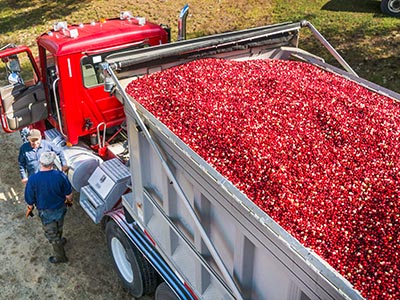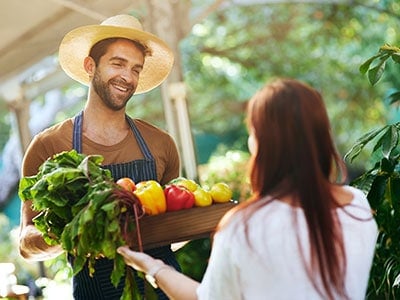Shipping Food with uShip
Food shipping requires a high level of care due to temperature specifics and legal restrictions. It’s important to choose the best food shipping company for your needs. As communication is of the utmost importance when delivering a sensitive product like produce, you need to know where your shipment is at all times. No matter the type of food being shipped, you want a carrier who can help take the stress out of shipping your temperature sensitive products.
When researching your carrier options, it’s important to find as many food shipping companies as possible. Be sure to compare them to each other – looking for experience, communication styles, and reviews. Price of shipping matters as well, but you may not always want to go with the cheapest option. With uShip, we provide shipping quotes, reviews, and the ability to talk to the transporters directly, all in one place.

HOW TO SHIP PERISHABLE FOOD
A food is considered perishable if it is likely to decay, spoil, or become unsafe to consume if it is not kept frozen at/below 0 F ° or refrigerated at/below 40 F °. Keeping food within a specific temperature range slows bacterial growth and helps to prevent foodborne illnesses or spoilage bacteria. The following are examples of food items that need to be kept at a certain temperature to stay safe for consumption:
- Poultry
- Meat
- Fish
- Dairy products
- Fruit
- Eggs
- Cooked leftovers
HOW TO SHIP PERISHABLE FOOD
A food is considered perishable if it is likely to decay, spoil, or become unsafe to consume if it is not kept frozen at/below 0 F ° or refrigerated at/below 40 F °. Keeping food within a specific temperature range slows bacterial growth and helps to prevent foodborne illnesses or spoilage bacteria. The following are examples of food items that need to be kept at a certain temperature to stay safe for consumption:
- Poultry
- Meat
- Fish
- Dairy products
- Fruit
- Eggs
- Cooked leftovers
USE FOOD SHIPPING PACKAGING
Whether you decide to use a carrier who provides reefer shipping or one that offers non-refrigerated methods, it is recommended that your food be properly packaged. The following are items needed to help keep food at adequate temperatures.
- Insulated Containers: Invest in sturdy, insulated styrofoam containers for all items you need to keep cool or frozen.
- Coolants: Depending on what you’re shipping, you can either line the container or you can add a cooling agent (gel packs, dry ice, etc.) inside the packaging.
- Alternative Insulation: If choosing not to use a styrofoam container, there are alternative products that can offer sufficient insulation. These options include air-filled insulated liners, insulated pads, insulated liners, and styrofoam cut sheets.
- Absorbents: If your food can thaw, be sure to place an absorbent pad or mat on top of your liners. Double bag or wrap if necessary.
- Padding: Once your goods are in the packaging, pad and pack to minimize movement during transit. Consider materials like bubble wrap or packing peanuts to provide at least 2 to 3 inches of protection.
- Seal Food: Keep food fresh by wrapping goods in plastic wrap, shrink wrap, or foil.

Shipping Baked Goods
Sealing your baked goods efficiently saves the freshness during shipment. You can use plastic wrap to seal delicate food, and use shrink wrap for sturdier food items. Additionally, you can freeze food, such as cupcakes or items with decorative frosting, to be sure they hold up during transport. If you’re shipping baked goods, you want them to be as airtight as possible.

HOW TO SHIP FROZEN FOOD
Shipping frozen food is similar to shipping refrigerated foods. The key difference is that in order to ship frozen items, dry ice must be used to ensure items stay frozen long enough. Additionally, dry ice can only be used to ship over state lines, not internationally. As international flights take additional time, items are unlikely to keep safe temperatures during delivery.
- Keep Items Cool: Thoroughly freeze or cool food prior to shipment. It is best that they stay chilled until the last possible moment.
- Use Insulated Containers: Just like refrigerated foods, styrofoam or cold shipping boxes are needed to package the items.
- Dry Ice: Use dry ice as the coolant to keep your product frozen. Make sure to write down the amount of dry ice used in order to give the information to the shipping carriers.
- Shipping Carriers: Since keeping food frozen is slightly more difficult than keeping food cool, choosing the fastest shipping option available to you is advised.
HOW TO SHIP FROZEN FOOD
Shipping frozen food is similar to shipping refrigerated foods. The key difference is that in order to ship frozen items, dry ice must be used to ensure items stay frozen long enough. Additionally, dry ice can only be used to ship over state lines, not internationally. As international flights take additional time, items are unlikely to keep safe temperatures during delivery.
- Keep Items Cool: Thoroughly freeze or cool food prior to shipment. It is best that they stay chilled until the last possible moment.
- Use Insulated Containers: Just like refrigerated foods, styrofoam or cold shipping boxes are needed to package the items.
- Dry Ice: Use dry ice as the coolant to keep your product frozen. Make sure to write down the amount of dry ice used in order to give the information to the shipping carriers.
- Shipping Carriers: Since keeping food frozen is slightly more difficult than keeping food cool, choosing the fastest shipping option available to you is advised.
How Much Does it Cost to Ship Food?
The average cost for food shipping depends on the distance, timeframe, and what you’re shipping. It costs $2.24 per mile to transport food less than 100 miles, but costs $1.46 per mile to transport food less than 1000 miles.
Visit our cost to ship food and beverages page for an inside look at the uShip food shipping process. There, you’ll be able to view food shipments completed on the uShip marketplace, so you can get a good idea of what your shipment may cost.

Using uShip for your Food Delivery
Finding and booking a carrier on uShip is easy! Follow these simple steps to start shipping your frozen or refrigerated food items today!
- Create a Listing: Create your shipment listing detailing your needs for the transport. Include dates for pick-up and delivery, weight, dimensions, and any special care your food requires.
- Get Quotes: Once you have completed the listing, food shipping companies will start sending you quotes to move your shipment. So that you know you’re getting the best deal on your shipping, carries will offer you their rates to compete for your business.
- Check Their Profile: As the quotes come in, you’re able to talk to the carrier directly and check out their carrier profile. There, you’ll find their shipping history, their customer rated reviews, and more information about their company.
When you find a carrier at the right price with the right services, accept the quote and begin working with them directly. Additionally, track your shipment with uShip tracking and be sure to work with the carrier to keep the transit time to 30 hours or less.
READY FOR YOUR FOOD SHIPPING QUOTES?
Get StartedNeed to transport livestock?
Learn MoreStates